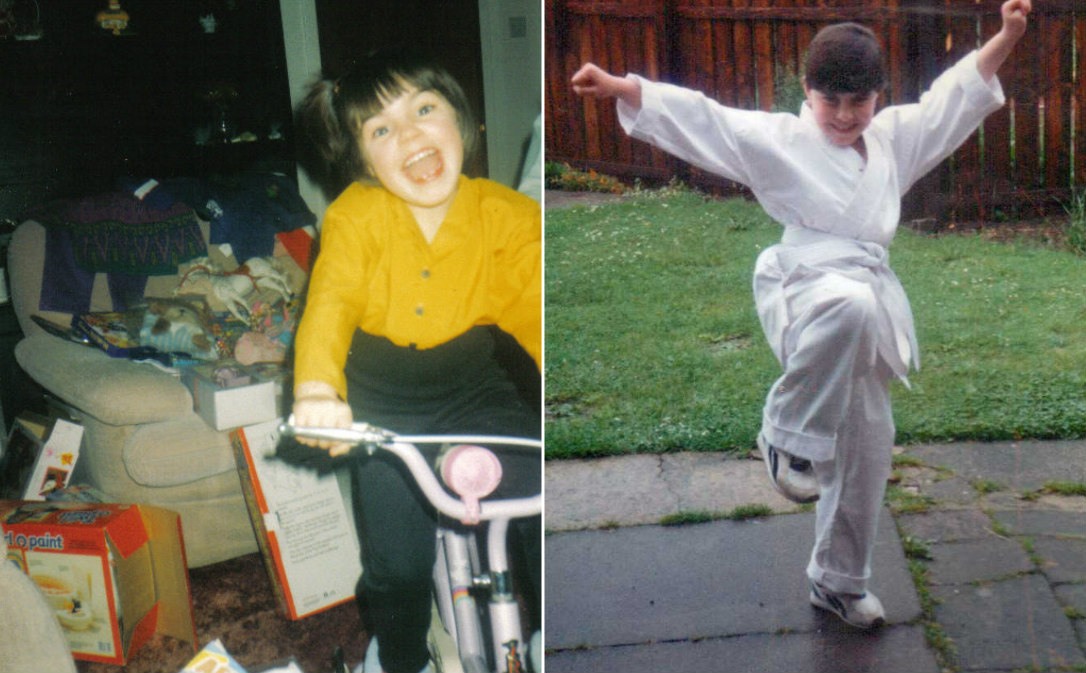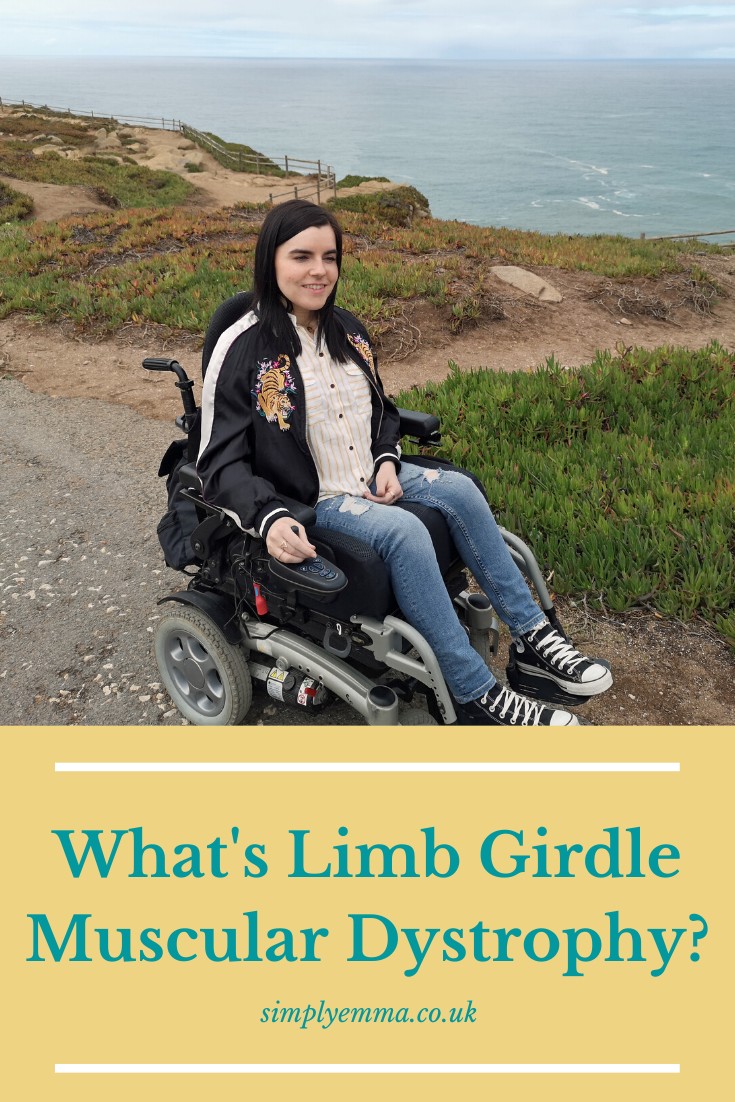As many of you will know, I have Muscular Dystrophy. What you may not know is what rare type of Muscular Dystrophy I have. In this post, I’m going to explain all about my condition, Limb Girdle Muscular Dystrophy (LGMD) and how it affects me, and share a little background story on when/what symptoms I displayed and how I was diagnosed.
What is Limb Girdle Muscular Dystrophy (LGMD)?
Limb Girdle Muscular Dystrophy (LGMD) is a group of progressive muscle-wasting conditions with over 30 different subtypes. LGMD mainly causes wasting (atrophy) and weakness of the shoulder and pelvic girdle muscles, which are the proximal muscles of the arms and legs (around the hips, thighs and shoulders muscles). Other muscles can be affected including the heart and breathing.

The shoulder ‘girdle’ is the bony structure that surrounds the shoulder area, and the pelvic ‘girdle’ is the bony structure surrounding the hips. Together, they are called the “limb girdles” and what has given this rare condition its name.
What causes Limb Girdle Muscular Dystrophy (LGMD)?
The many forms of LGMD are caused by different genetic mutations. These genes hold the instructions for making proteins that are required for muscle function (maintenance and repair).
When a mutation in the LGMD gene is present, it means the cells can’t produce the proteins needed for healthy muscle function causing progressive muscle weakness.
There are two major groups of LGMDs; LGMD1 and LGMD2. They are classified by their inheritance patterns.
Limb Girdle Muscular Dystrophy type 1 (LGMD1) have an inheritance pattern called autosomal dominant. This means an abnormal gene from one parent is enough to cause the condition.
Limb Girdle Muscular Dystrophy type 2 (LGMD2) have an inheritance pattern called autosomal recessive. This means two abnormal copies of the causative gene (one from each parent) are required for the disease to occur.
I have Limb Girdle Muscular Dystrophy type 2D which means I received the flawed gene from my Mum and Dad. At a recent hospital appointment, I was told by my specialist that it is now named LGMDR3.
There is a 25% chance of both parents passing on the abnormal gene and having an affected child.
What are the symptoms of Limb Girdle Muscular Dystrophy (LGMD)?
Symptoms of LGMD can vary between the different subtypes. The onset of symptoms can also occur during childhood or even in adulthood. The severity and progression of Limb Girdle Muscular Dystrophy symptoms also greatly vary, but it appears that progression is faster when they occur in childhood.
I began showing symptoms of LGMD in my early childhood, a few years after my older sister was diagnosed with LGMD. My sister and I had the same symptoms during our childhood and have followed a similar progression throughout the years into adulthood.
Limb Girdle Muscular Dystrophy symptoms include:
- Soreness of the muscles and joints
- Walking with a waddle
- Difficulty standing from a sitting position
- Difficulty climbing stairs
- Toe-walking
- Tiredness and soreness from walking/running/cycling etc
- Difficulty lifting arms above the head

The progression of LGMD in my case has meant that as a child I could walk, run, cycle, and dress myself, I even went to Karate and dancing lessons.
As an adult, I cannot walk, so I use a powered wheelchair full-time and need help with all personal care.
Weakness in my shoulder area means that I cannot lift my arms, hold them outstretched, or lift heavy objects. This means I can’t do simple tasks like washing/brushing my hair and have difficulty applying my makeup. I can’t raise my arms to hug my family or scratch an itch.
The heart and breathing muscles can also be affected, leading to serious health problems. I have regular cardiology appointments where I have an electrocardiogram (ECG), echocardiogram (echo) and sleep studies to check and monitor my heart. Regular monitoring and tests with my respiratory team are also carried out.

I cannot produce a strong cough and therefore need help to do so. Having a common cold or flu can be incredibly difficult for me. I use a cough assist machine to help cough and clear secretions. Using this machine helps keep my lungs as strong as possible.
How is Limb Girdle Muscular Dystrophy (LGMD)? diagnosed?
Limb Girdle Muscular Dystrophy is diagnosed mainly by blood tests (creatine kinase level tests), muscle biopsies, and Electromyography (EMG).
My sister began showing symptoms before I did. The first thing our parents did was to make an appointment with our doctor. Initially, the doctor believed my sister just needed more activities and exercise, so referred her for six months of physiotherapy.
After six months of no improvement, the doctor referred her to a specialist for further investigation.
It was a long, daunting, upsetting, and frustrating process of various appointments with specialists. A blood sample was taken, which found dystrophin in her blood.
Then, a year or so later, I began showing the same symptoms as my sister. A blood sample was taken, and it was confirmed that I also had Muscular Dystrophy. Further tests were carried out, which involved my parents providing blood samples for DNA testing.
Both my sister and I had muscle biopsies, which involved removing tissue and cells from a specific muscle in our thighs. The muscle tissue was analysed and identified as the exact diagnosis of Limb Girdle Muscular Dystrophy type 2D (α-sarcoglycan deficiency) (autosomal recessive).
My sister and I were both around the age of seven when we were diagnosed.

How is Limb Girdle Muscular Dystrophy (LGMD)? treated?
There are currently no cures for LGMD but there are treatments to help manage and ease the symptoms. However, there is ongoing research with potential for promising results.
Physical therapy
Physiotherapy is beneficial and helps strengthen the muscle groups and maintain mobility and motion in the joints. As a child, up until the age of eighteen, I received weekly sessions with a physiotherapist. That stopped when I became an adult, but my Mum and partner have maintained my daily physio which includes passive stretching of my arms and legs.
Read more: 8 Easy Self Care Tips to Relieve Muscle Fatigue
Mobility Aids
Mobility aids can be used to help prevent falls and provide support for walking, accessing stairs, etc. Walking frames, railings/grab bars, stairlifts, braces, wheelchairs with specialist seating to maintain suitable posture are also used.
As a child (before I was a full-time wheelchair user), we had a stairlift installed in our family home to help me access the upstairs area where my bedroom and bathroom were (prior to having an extension built with a bedroom and wet room).
I also had ankle foot orthoses (AFO), which are plastic leg splints that help keep the feet and ankles in a good position for standing/walking and prevent contractures (shortening of muscles or tendons around joints that can limit mobility).
Speech and language
Chewing and swallowing can be affected by LGMD. I can sometimes have issues with random choking, and because I can’t produce a strong cough, it can be difficult to clear what has caused me to choke (when drinking or eating).
Speech and language specialists can help with dysphagia (swallowing difficulties) in adults and children with Muscular Dystrophy. They can help find safe ways to manage swallowing difficulties with exercise and treatments.
Heart and respiratory support
LGMD can affect the breathing muscles, so some people may need assisted ventilation. As I’ve mentioned before, I use a cough assist machine to help me produce a strong cough and clear secretions.
The heart should be monitored regularly for any complications (abnormalities and arrhythmias). Pacemakers and medications can be used as treatments in these situations.
To find out a little more about how LGMD affects me, check out the articles below.
5 Things I Do Differently Living With Muscular Dystrophy
How I transfer to and from my wheelchair using a Molift Quick Raiser Mobile Hoist
Accessible Makeup Products For Limited Hand Ability
My Identity And How My Disability Defines Me
Fatigue Management: Ways to Manage Muscle Fatigue with Muscular Dystrophy
8 Easy Self Care Tips to Relieve Muscle Fatigue
My parents perspective and thoughts on having two children with LGMD.
Parenting A Child With Muscular Dystrophy | Q&A With My Parents
My younger sisters perspective on growing up with two disabled siblings with Muscular Dystrophy.
Young Carers: My Sisters Perspective Of Caring For Disabled Siblings
My partners perspective from being in an interabled relationship.
Being In An Interabled Relationship: Q&A With My Caregiving Boyfriend
Disability, Sex & Dating As A Wheelchair User
Do you have LGMD or another form of Muscular Dystrophy? Please comment below about what your experience has been like.
Follow me on Twitter | Facebook | Instagram | YouTube’ | Pinterest
Sharing is caring!









17 Responses
💜💜💜
Thank you 🙂
It was almost like I was reading a story about myself. My symptoms and diagnosis came much later in life. I have LGMD2J. I had just turned 30 when I started seeing the neurologist my sister was seeing. We knew something would happen because my Daddy and all is brothers were all affected.
Thank you for your comment, Lena. I appreciate you sharing your story with me. Very interesting to know that your sister, Dad and uncles are all affected too. I hope you are keeping safe and well 🙂
Hello Emma I have LGMD type A this article is very much like mine. I was diagnosed aged 7 and stopped completely between 11/12. I’m now 32 and use a hoist for all movements I have a cough assist and use a NIV most of the time. I like reading your blog about all the places you travel .
Hi Colleen. Thank you so much for your comment. I really appreciate your kind words and I’m delighted you enjoy reading my blog about the places I’ve been. May I ask where you live? Thanks again 🙂
Hi Emma
Thanks for replying I live in Blackburn, Lancashire
I can’t believe how very similar that is to myself being diagnosed at 28 , thankyou so so much for sharing your story it’s a very good insight to Myscular dystrophy limb girdle!! I had a biopsy at 28 to tell me me I had limb girdle type 2c !! That was 20 yrs ago , wish you all the best , I know your pain ur not along god bless you both xx
Hi Nikki. Thank you so much for your comment. I appreciate you sharing your story and how you were diagnosed with LGMD2C. I hope you stick around and enjoy some more of my posts – I plan on writing more LGMD related topics. Thanks again and I hope you are keeping safe and well. Take care 🙂
Emma, well done in a bad situation. I have followed you whole heartedly since I discovered your blog. I have learned a lot–both the scientific details, and from your beautiful accounts. It has made my journey with Stage Four Renal Cell Cancer easier. I love Scotland and I visit when ever possible. I love your valor. It is catching. Three years ago, I climbed Arthur’s Seat with a special all-terrain walker, inspired by you. I also nominated you for a Diversity Award. Blessings on you going forward!
Hi Viola. Thank you so much for your lovely kind comment. It means so much to know that my posts have helped you and inspired you to climb Arthur’s Seat with an all-terrain walker. Fantastic! I’m sorry to read about your journey with cancer. I wish you all the best. I hope you can visit Scotland soon (once things get back to some normality). It makes me happy that you love Scotland – it’s beautiful here 🙂 Thank you for the Diversity Award nomination – greatly appreciated. Take care and speak soon.
Very different trajectory here — always slow, always weaker than other kids, always thought I was “lazy,” always had a lot of pain in my feet and legs when walking but just powered through it. Symptoms got worse very, very slowly throughout my early and mid-adulthood. By my mid-50s, I could no longer lower myself to the ground to sit, and if I did manage to get down on the ground, I had to find something to hold onto to help drag myself up again; couldn’t cross one foot over the other knee; found stairs increasingly difficult; found it hard to step into a bathtub; etc. etc. After being ignored by the first neurologist I went to in 2015, I finally moved from my small town to a major city with good research hospitals and great doctors and I’m working with a wonderful neurologist here. I’m now 64, and am just now being diagnosed with LGMD. My type apparently is one of those that hasn’t yet had its genetic profile determined. I’m having a biopsy next week and we hope that will give us more information. I can still walk, with a cane in one hand and holding my husband’s arm with the other. We have always loved traveling in Europe and the UK and I’m determined to do so again once we get through the madness of the current administration here in the US and get Covid-19 under control so that Americans won’t be pariahs any more! I’m delighted to find this blog. Thank you so much for your courage and example.
Hi Elizabeth. Thank you so much for sharing your experience with LGMD and how it has affected you over the years. I hope all went okay with the muscle biopsy? When are you likely to find out the results? I hope you don’t have to wait too long. Please keep me posted – I’d love to know how you are getting on. Hopefully, you will be able to visit Europe and the UK again soon. Thanks again for your kind comment. Take care 🙂
Hi i have limb girdle I’m 51 in the last 6 mths I have no energy does anyone take medication I take none I have seen no specialists since leaving school
Hi Shaun. I’m so sorry to read that you are experiencing a lack of energy recently. I have a blog post about fatigue management that you may find helpful, you can read it here – https://www.simplyemma.co.uk/ways-to-manage-muscle-fatigue-with-muscular-dystrophy/
Additionally, have you thought about taking some supplements to boost you a little?
I also have a post on my tips to relieve muscle fatigue – https://www.simplyemma.co.uk/easy-self-care-tips-relieve-muscle-fatigue/
I hope these are helpful. Let me know if you have any questions. Take care.
Hi Emma
Thank you for writing this piece. I have only just come across it as i have been feeling exhausted and wanted to know why.
Like others I felt it was so poignant and all me, however the tips you have shared I will try as I better understand. I think the less I do or more rest I take feels like Im lising more of my independence. I understand Im simply not listening to my body which is doingvalk it can to keep me going.
Thank you again for sharing and I hope you and your sister are well.
Hi Barry. Thank you so much for your comment. I’m so pleased you came across my blog post and have found it helpful. I really hope the tips I’ve shared can be helpful to you and your fatigue. I’m not sure if you have already read it, but I have two blog posts all about muscle fatigue. I will share the links here with you in case it can be useful to you. Please let me know if you have any questions.
https://www.simplyemma.co.uk/ways-to-manage-muscle-fatigue-with-muscular-dystrophy/
https://www.simplyemma.co.uk/easy-self-care-tips-relieve-muscle-fatigue/